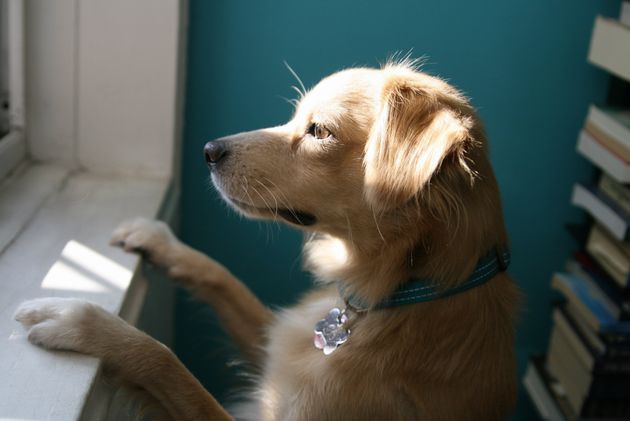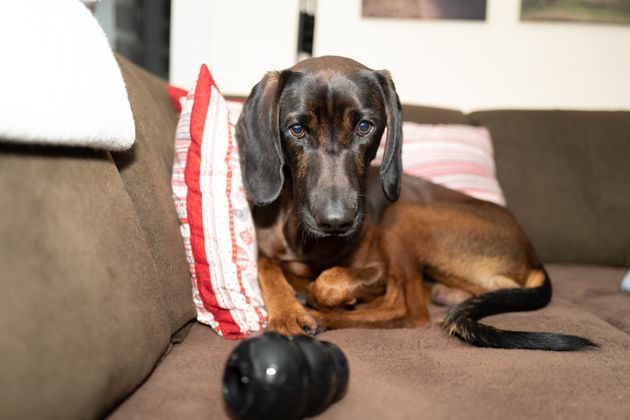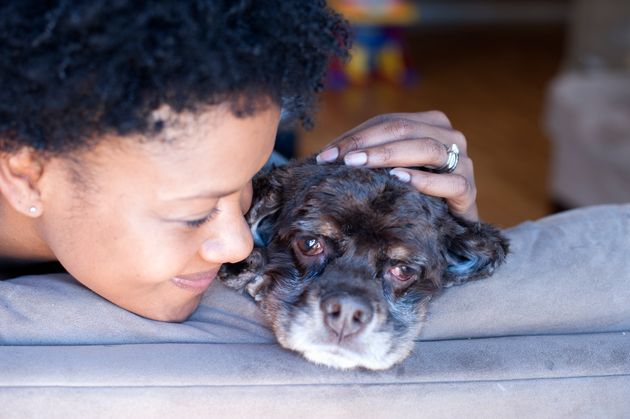
Dog adoptions and sales soared during the pandemic, when many people were spending most, if not all, of their time at home. Now as case numbers decline and vaccination rates rise, people are starting to venture out more and offices are beginning to open up once again. The return to work is going to be an adjustment for us humans — and for our pets too.
Animals who were used to being home alone during the day pre-Covid-19 may adapt more easily to this transition than those who were born or adopted in the last year or so.
“Many [dogs] will probably adjust relatively quickly and well. Some may actually enjoy having quiet time if they have been overstimulated due to their families being around constantly,” said Candace Croney, a professor of animal behavior and well-being at Purdue University’s College of Veterinary Medicine.
“Others may have a harder time, particularly if they were inclined toward separation anxiety prior to stay-at-home orders going into effect,” she added. “Dogs adopted from shelters who have had no experience in the home beyond what they experienced during the pandemic may need additional support.”
Rachel Malamed, a veterinary behaviourist in Los Angeles, said that she’s already noticed an uptick in separation anxiety cases in her practice since people have begun returning to work.
So what does separation anxiety look like in dogs? The most common signs are destructive behaviour (like chewing, digging or scratching), attempting to escape from an enclosure or room, going to the bathroom inside even if house-trained, and excessive barking, howling or whining that occurs when they’re left alone. More subtle signs, according to Malamed, include pacing, panting, standing by doors or windows and not eating while you’re gone.
If you’re not sure how your dog is coping with your absence, set up a camera so you can observe their behaviour.
How To Prepare Your Pup In Advance

Don’t wait until your first day back at the office to get your dog acclimated to the new schedule. Start getting them ready now.
“Animals thrive when they have consistent, predictable routines,” Croney said. “So if feeding, play, rest and exercise times are going to change when people head back to work, those changes should be introduced well in advance of the back-to-work date. Gradually shifting over the course of a few weeks to the new schedule and sticking with it should help ease the transition.”
Here are a few things you can do ahead of time, according to experts.
Practice short independence exercises while you’re still at home. Then gradually increase the duration and distance.
“During what remains of the work-from-home period, have the dog relax in a room away from their people while keeping them well-occupied with favourite toys and treats that will hold their attention for that time period,” Croney said.
Using high-value, long-lasting treats will help them connect these independent moments with something fun and positive.
Once your dog has built up some tolerance, practice leaving the house for very short periods of time — just five or 10 minutes to start. Grab the mail or take a quick walk around the block.
“As your dog learns to associate your departures with good things and feels safe because you come back before he shows even subtle signs of stress, you can start to increase the time slowly and at a rate that is comfortable for him,” she said. “The goal is that your dog has a positive experience and is not stressed during these exercises.”
Before you leave, set your dog up in an area of the house that’s both safe and familiar to them.
Choose a place where they are the most comfortable and least likely to hurt themselves. Know that while some dogs feel content and secure in their crate when their owner is away, others may feel more anxious being confined. This can exacerbate stress and even lead to injury if they try to escape, Malamed noted.
Desensitise your dog to departure cues like putting on your shoes or jingling your car keys.
“These are common cues that become predictors that you are leaving, and often this is when dogs start to become stressed,” Malamed said. “Go through your normal leaving routine and present these cues when you don’t actually have to leave.”
Don’t make a big fuss about hellos and goodbyes.
If you make your arrivals and departures drawn out or overly emotional, your dog will pick up on that energy, which can heighten their anxiety.
“When you come home, wait until your dog is calm and then greet him calmly,” Malamed said.
Remember to also reward your pup with praise or physical touch during times they’re not actively seeking your attention (e.g., when they’re just lying on the couch or quietly playing with a toy). This will help reinforce calm behaviour.
What To Do When You Go Back To The Office

Before you leave for work, carve out time for a morning walk and play session with your pup. The exercise will tire them out so they’ll sleep while you’re gone.
Keep providing your dog with special toys and treats when you leave for the day.
“Continue reinforcing the message that your absence means wonderful resources appear that aren’t offered at other times,” Croney said. “To achieve this goal, make sure you save at least a few very special — and safe — toys and treats only for absences.”
If possible, have a loved one, neighbour or dog walker stop by to take your pup out midday. Look into doggy day cares in your area if you work long hours and don’t have someone nearby to help out.
You can also leave the TV, radio or a white noise machine at low volume for some soothing background noise.
If you happen to come home from work to find a soiled carpet, scratches on the furniture or a defluffed pillow, you may be frustrated. But do not punish the dog, Malamed said. Punishment can increase your pet’s anxiety and damage the bond you’ve built.
“Remember, your dog is not performing these behaviours out of spite but rather from a state of panic — or fight or flight,” she said. “These behaviours stem from a physiologic response to stress that they cannot control.”
Plus, your dog will not connect the punishment to the unwanted behaviour that may have occurred hours before you got home.
If your pet is showing signs of separation anxiety, reach out to your veterinarian or a veterinary behaviourist for advice and support. Without intervention, separation anxiety can worsen over time and become a potential safety and welfare issue for the pet, Malamed said. A professional can also rule out potential medical causes or other issues, such as boredom, that could be driving your dog’s behaviour.


